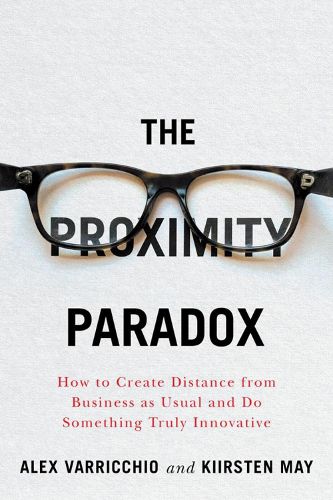Readings Newsletter
Become a Readings Member to make your shopping experience even easier.
Sign in or sign up for free!
You’re not far away from qualifying for FREE standard shipping within Australia
You’ve qualified for FREE standard shipping within Australia
The cart is loading…






You’re too close to your business, and it’s killing your creativity
Traditional business structures love stability and predictability. Yet many organisations believe the two essential ingredients for long-term success are creativity and innovation. Kiirsten May and Alex Varricchio, founders of the marketing agency UpHouse, call the relationship between these two opposing expectations the Proximity Paradox ™ - the belief that those who are closest to a subject are best-qualified to innovate for it, when, in reality, intense proximity limits creativity. Instead, people need to create distance from challenges in order to see the best way forward. May and Varricchio believe that until we can separate innovation and execution within ourselves, we will only innovate to the level at which we can execute the idea. To be effective, we need to create distance between our innovation brain and our execution brain.
Unpacking ten common Proximity Paradoxes that affect a company’s people, processes, and industry, the authors share some practical ideas to create the distance necessary for your next great idea. An especially valuable book for creatives, and non-creatives in creative industries, but equally applicable to all businesses that depend on innovation, The Proximity Paradox encourages us to ask hard questions about how we work, how our businesses are structured, and why we routinely find our creativity at odds with what’s asked of us as executors and stewards of the bottom line.
‘The endnotes provide plenty of research and online resources, which should have strong appeal…A respectable business work recasting vintage techniques that may be compelling to a more scholarly audience.’ - Library Journal
‘Innovative…Marketers and those tasked with innovation will find this work full of food for thought. It’s a much-needed perspective on how to escape inside-the-box thinking.’ - Publisher’s Weekly
$9.00 standard shipping within Australia
FREE standard shipping within Australia for orders over $100.00
Express & International shipping calculated at checkout
You’re too close to your business, and it’s killing your creativity
Traditional business structures love stability and predictability. Yet many organisations believe the two essential ingredients for long-term success are creativity and innovation. Kiirsten May and Alex Varricchio, founders of the marketing agency UpHouse, call the relationship between these two opposing expectations the Proximity Paradox ™ - the belief that those who are closest to a subject are best-qualified to innovate for it, when, in reality, intense proximity limits creativity. Instead, people need to create distance from challenges in order to see the best way forward. May and Varricchio believe that until we can separate innovation and execution within ourselves, we will only innovate to the level at which we can execute the idea. To be effective, we need to create distance between our innovation brain and our execution brain.
Unpacking ten common Proximity Paradoxes that affect a company’s people, processes, and industry, the authors share some practical ideas to create the distance necessary for your next great idea. An especially valuable book for creatives, and non-creatives in creative industries, but equally applicable to all businesses that depend on innovation, The Proximity Paradox encourages us to ask hard questions about how we work, how our businesses are structured, and why we routinely find our creativity at odds with what’s asked of us as executors and stewards of the bottom line.
‘The endnotes provide plenty of research and online resources, which should have strong appeal…A respectable business work recasting vintage techniques that may be compelling to a more scholarly audience.’ - Library Journal
‘Innovative…Marketers and those tasked with innovation will find this work full of food for thought. It’s a much-needed perspective on how to escape inside-the-box thinking.’ - Publisher’s Weekly